August 3, 2016
by Carole Zangari -
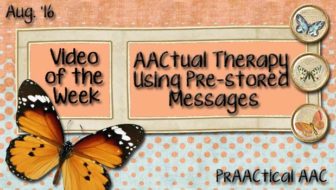
In the past few years, we’ve written a lot about the value of AAC systems that are rich in single core vocabulary words. Our position has always been, however, that many users of AAC will also benefit from fringe vocabulary words and selected prestored messages. You can read more about that here. To be sure, pre-stored messages, including phrases, sentences, and full questions, have their drawbacks. The main downside relates to the lack of flexibility they offer. Once programmed into a device, the communicator has to use them just the way they are. If he/she wants to say a variation of that message, they are out of luck. In the context of a robust system, however, this isn’t as problematic as it sounds. Individuals who have been provided with robust AAC systems can go to their single word vocabulary to be more precise if the pre-stored message doesn’t capture exactly... [Read More...]
Filed under: Video of the Week
Tagged With: prestored messages, therapy
July 13, 2016
by Carole Zangari -
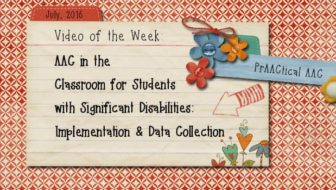
Today, we head back to AbleNet University for the second part of AT specialist and consultant Kelly Fonner’s presentation on advancing the communication skills of students with the most significant disabilities. In this video, Kelly goes deeper into implementation issues and discusses strategies for meaningful data collection. Missed the first part? You can check that out here. Kudos to Kelly and AbleNet University for hosting this series and making these videos freely available. Direct Link to Video: https://www.youtube.com/watch?v=BywUo_2es2E&ab_channel=ableUOn-demandProfessionalDevelopment
Filed under: Video of the Week
Tagged With: beginning communicator, classroom, implementation
July 6, 2016
by Carole Zangari -
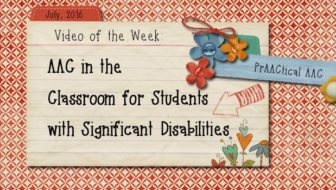
Most classrooms that include children with the most significant disabilities are comfortable with low tech AT and use it frequently throughout the day. In today’s video, AT consultant Kelly Fonner, discusses strategies for maximizing the use of those technologies and progressing to more advanced communicative options. A frequent presenter at international, national, and state conferences, Kelly shares ideas for taking what already works in these classrooms and moving to the next level. As always, she provides clear explanations, rationales, and the all-important ‘how-to’ for implementing additional strategies and technologies. Many thanks to Kelly and AbleNet University for making this video available. Direct Link to Video: https://www.ablenetinc.com/customer/account/login?referer=aHR0cHM6Ly93d3cuYWJsZW5ldGluYy5jb20vcmVzb3VyY2VzL3JlY29yZGVkX3dlYmluYXJzP3M9a2VsbHkrZm9ubmVyJnNvcnQ9JnBvc3RfdHlwZT1yZWNvcmRlZF93ZWJpbmFycw
Filed under: Video of the Week
Tagged With: beginning communicator, implementation ideas, low tech
June 29, 2016
by Carole Zangari -
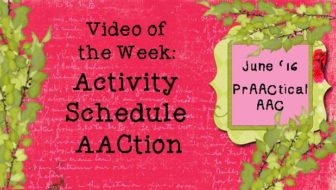
Over the years, we’ve written quite a bit on the prAACtical powers of visual schedules. Activity schedules, known also as mini schedules or task schedules, are great ways to help AAC learners understand what will be happening in a particular activity. Understanding what events will take place helps us all better prepare ourselves for active and appropriate participation in those events. In today’s post, we feature a number of short videos with information on and examples of this strategy. Thanks to the Watson Institute for creating and sharing these videos. Going to the Doctor’s Office Going to the Library Going to Physical Education (PE) Class Going to a Fast Food Restaurant Getting Ready for Bed
Filed under: Video of the Week
Tagged With: activity schedule, schedules
June 22, 2016
by Carole Zangari -
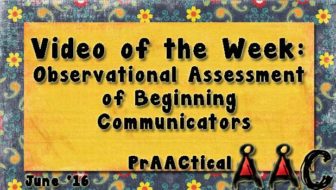
In last week’s video, we heard from SLP Maureen Nevers about the principles and practices used in assessing individuals who are at the beginning stages of communicative development. Today, we continue that theme and focus more specifically on using observation to collect assessment data on the form and function of communication. In this video, Maureen works through some video examples to demonstrate how brief observations of interaction can yield useful information about how and why the individual is communicating. You can visit their Communication Training Series webpage to see more from this wonderful team and get the specific resource documents for this presentation. Many thanks to the Angelman Syndrome Foundation for creating and sharing these videos. Direct Link to Video: https://www.youtube.com/watch?v=1qvvKNZEGMs&list=PLihsTkrStCHZVZBHDC0Qr7z10cYWC0ltx&index=36
Filed under: Video of the Week
Tagged With: assessment, beginning communicator
June 15, 2016
by Carole Zangari -
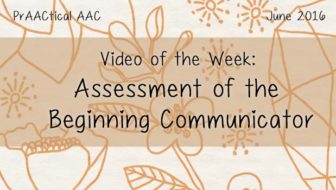
Looking to strengthen your assessment practices with beginning users of AAC? The Angelman Syndrome Foundation’s Communication Training Series has a two-part presentation on this topic that will be of interest to professionals and families alike. In this video, SLP Maureen Nevers discusses a range of prAACtical strategies and tools for gathering meaningful assessment data that helps guide intervention. One important note: Don’t skip this just because you are not currently working with individuals who have Angelman Syndrome. Like their other videos, the information in this presentation is relevant to those working with children, teens, and adults with a wide range of developmental disabilities. Direct Link to Video: https://www.youtube.com/watch?v=pgrsr8a2EKA&index=35&list=PLihsTkrStCHZVZBHDC0Qr7z10cYWC0ltx Kudos to the Angelman Syndrome Foundation for this outstanding series of training videos, and for making them freely available. Interested in this topic? Stay tuned for the second video on this topic in a future post.
Filed under: Video of the Week
Tagged With: assessment, beginning communicator, video
June 8, 2016
by Carole Zangari -

Parents, therapists, and educators share the common goal of helping AAC learners be as independent as possible and assert control over their own communication systems. One step toward this kind of self-advocacy is to teach our clients to add messages to their own AAC systems. In this video, Lindsey Cargill demonstrates how she introduced this to Katya. Enjoy! Direct Link to Video – https://www.youtube.com/watch?v=zo3x333cIy0
Filed under: Video of the Week
Tagged With: self-advocacy
June 2, 2016
by Carole Zangari -
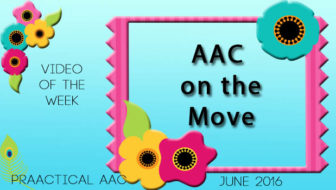
Strategies, tools, and implementation tips. SLP Maureen Nevers packed a lot into this terrific video on AAC strategies. Enjoy! Direct Link to Video – https://www.youtube.com/watch?v=8m9Qow6kWN8
Filed under: Video of the Week
Tagged With: implementation
May 25, 2016
by Carole Zangari -
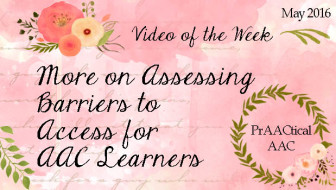
Today, we feature the second part of the presentation by Dr. Rae Sonnenmeier on assessing barriers to AAC. (You can see Part 1 here). In this video, she provides more in-depth information and prAACtical solution strategies. Many thanks to the Institute on Disability at the University of New Hampshire for making this available. Direct Link to Video – https://vimeo.com/86724224
Filed under: Video of the Week
Tagged With: access, assessment
May 18, 2016
by Carole Zangari -
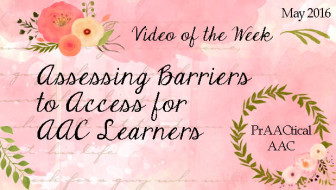
We’re continuing our journey of strengthening AAC assessment practices. In today’s featured video, we return to the Institute on Disability at the University of New Hampshire to consider additional ways to make our evaluation practices more meaningful. Many thanks to their AT team and Dr. Rae Sonnenmeier for this helpful information. Direct Link to Video – https://vimeo.com/80741615 Links to client videos referred to in the presentation Tyler: https://www.youtube.com/watch?v=WzqNPx1OVTU Holly: https://www.youtube.com/watch?v=woCsgnXwOyg
Filed under: Video of the Week
Tagged With: assessment









